
This standard applies to protective helmets for industry where the helmet is intended to protect a static user from falling hazards. A series of impact tests must be carried out using a fixed head-form and a falling weight in order for a helmet to meet this standard.
In accordance with EN 397, marking of the helmet should include the year and quarter of manufacture. Period of obsolescence of the helmet and its components must be declared on the User Sheet which is delivered together with the helmet.
All Portwest Helmets Have A Shelf Life Of 7 Years From Manufacturing Date
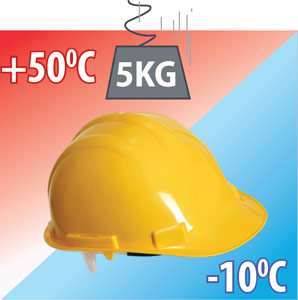
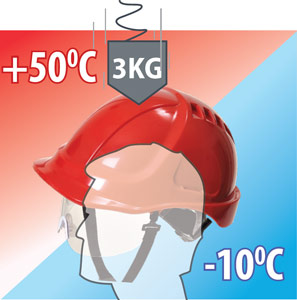
The helmet must not allow more than 5Kn of energy to spread to the head after a fall of a 5kg weight from a 1 meter height. This test is performed at room temperatures of both +50°C and -10°C.
The tip of the test mass used (3kg from 1m height) must not come into contact with the skull. This test is performed at room temperatures of +50°C and –10°C.
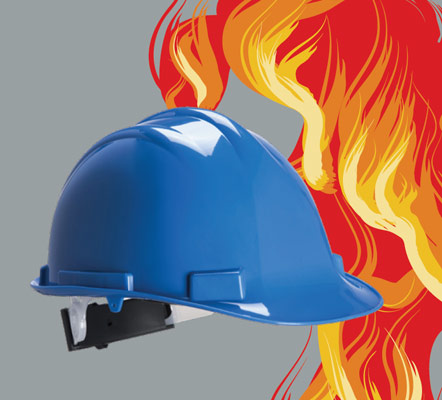
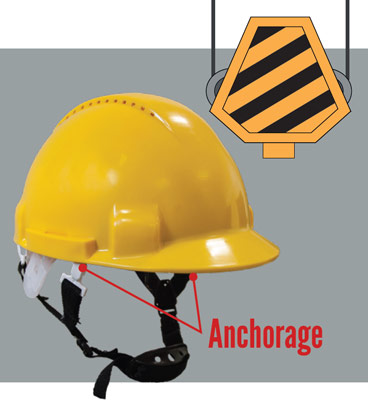
The helmet is exposed to a flame and it must not burn with flame emission more than 5 seconds after removal of the flame source.
Helmets can only protect when retained on the head. EN 397 requires that either the helmet shell or the headband is fitted with a chinstrap or with the means of attaching one, i.e. anchorage points. Chin strap (where present) shall be released at a force between 15kg–25kg (150N–250N) - due to failure of the anchorages only. Test conducted at +50°C after the helmet being submitted to penetration test.

EN353-2 relates to systems made up of a line intended to be fixed (either temporarily or permanently) to a structure at the top only, on which a travelling device is attached. The user connects to this travelling device when climbing or descending – in the case of a fall, the travelling device should grip the line and arrest the fall.
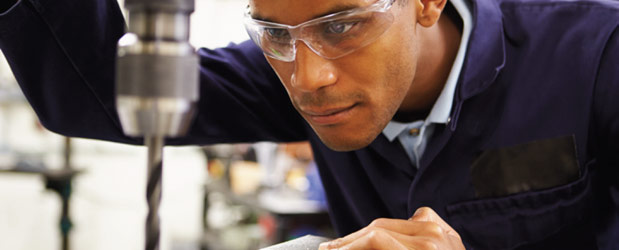
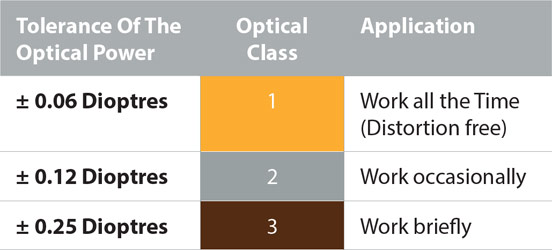
Tests include: transmission and diffusion of light, refractive properties, resistance to aging (stability to heat and resistance to UV), corrosion and ignition. Results of the testing define the Optical Class of the eye protector: which falls into 1 of 3 categories, where 1 is the highest and 3 is the lowest as indicated in the table. These categories define the quality of the lens in terms of how much or how little distortion is experienced by the wearer.
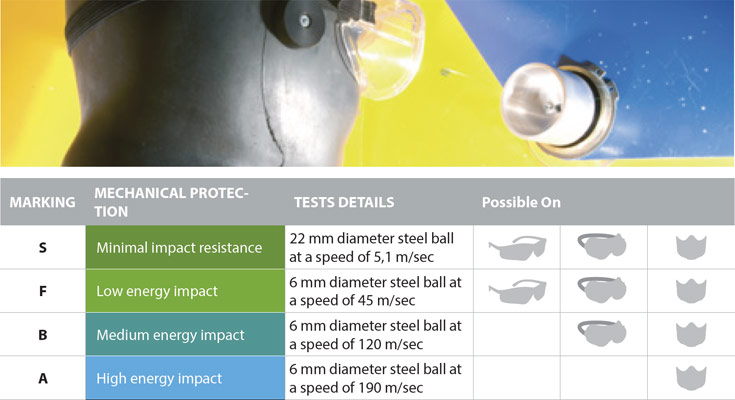
This test (applicable to both lens and frame) determines the impact resistance of the eye protector (spectacles, goggles or visors) to withstand flying objects without cracking or shattering. The test is performed with steel balls of different diameters and weights which are used to strike the lens and frame at different speeds as indicated in the table. This results in 4 levels of mechanical protection denoted by the markings; 'S' 'F', 'B' or 'A' on the eye protector where 'S' is the lowest grade, offering the least amount of protection and 'A' is the highest grade offering maximum protection under the standard.
Note: spectacles can only get a S or F marking, goggles can have a S, F or B, whereas grade A is applicable to visors only.

EN 166 also describes other optional tests which must be applied should the manufacturer wish to make additional claims regarding protection. For example, the Impact Resistance Against High Speed Spectacles At Extreme Temperature is conducted on spectacles/goggles and visors conditioned at extreme temperatures from -5°C / +55°C, resulting in similar markings as the above table, with a T denoting temperature: FT / BT / AT. Note: This does not apply to the S marking category.

See the table to the left to see other optional requirements and their corresponding markings for EN 166.
Enhance your safety while working in harsh conditions with the Portwest Endurance Plus Visor Helmet in Orange. This helmet is crafted with an ABS shell and features a variety of safety enhancements including a retractable clear visor and electrical insulation, providing a high level of protection and comfort. Discover more about its outstanding features below:
With the Portwest Endurance Plus Visor Helmet in Orange, you gain a reliable partner that ensures your safety in a variety of working environments. Be prepared and protected with this well-designed safety helmet. Get yours today!
Please see our PPE disclaimer at the bottom of the page.
Specifications are subject to change - See Terms & Conditions for more info
Portwest has been independently rated by Ecovadis for its environmental, social, and ethical performance and achieved a silver rating, meaning they are in the top 25% of globally rated companies.
The pillars taken into consideration include the environment, labour practices and human rights, ethics, and sustainable procurement.
This product conforms with essential health and safety requirements as set out in European Directives.
This product is CE marked as a Category 3 item for complex design.
Features a surface coating intended to mitigate scratch effects on the lens.
Features a surface treatment which helps reducing fogging effects on the lens.
An optional test for safety helmets, it indicates the resistance to lateral compressions.
An optional test for safety helmets, it indicates the resistance to molten metals and hot solids projection.